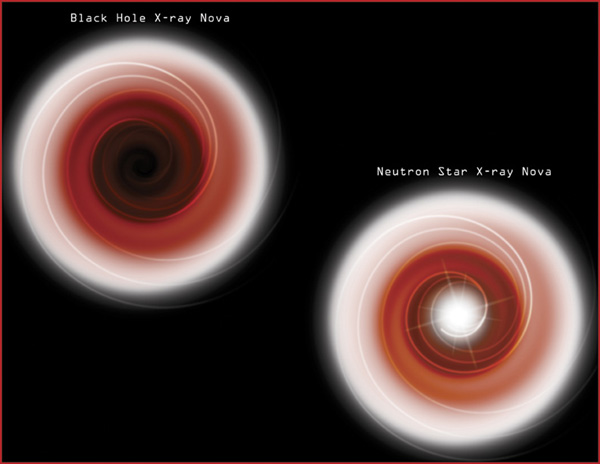Credit & Copyright: M. Weiss, CXC
Explanation:
Q: Why are
black holes black?
A: Because they have an
event horizon.
The event horizon is that one-way boundary predicted by
general
relativity beyond which nothing, not even light, can return.
X-ray
astronomers using the space-based Chandra Observatory now
believe they have direct for event horizons - therefore
black holes - in binary star systems which can be
detected in x-ray light.
These binaries, sometimes called x-ray novae, are
known to consist of relatively normal stars dumping
material on to massive, compact companions.
As illustrated,
the material swirls toward the companion in an
accretion disk which itself glows in x-rays.
If the compact companion is a neutron star
(right), the material ultimately smashes into the solid surface
and glows even more brightly in high energy x-rays.
But if it is indeed a
black hole with a defining event
horizon, then the x-ray hot material approaches the speed of
light as it swirls past the surface of no
return and is lost from view.
Recent
work describes observations of two classes of
x-ray binaries,
one class 100 times fainter than the other.
The results imply the presence of an event horizon in the
fainter class which causes the extreme difference in x-ray
brightness.
1999 2000 2001 2002 2003 2004 2005 2006 2007 2008 2009 2010 2011 2012 2013 2014 2015 2016 2017 2018 2019 2020 2021 2022 2023 2024 2025 |
Yanvar' Fevral' Mart Aprel' Mai Iyun' Iyul' Avgust Sentyabr' Oktyabr' Noyabr' Dekabr' |
NASA Web Site Statements, Warnings, and Disclaimers
NASA Official: Jay Norris. Specific rights apply.
A service of: LHEA at NASA / GSFC
& Michigan Tech. U.
|
Publikacii s klyuchevymi slovami:
chernye dyry - black hole - neitronnye zvezdy - x-ray binary - neutron star - rentgenovskie dvoinye
Publikacii so slovami: chernye dyry - black hole - neitronnye zvezdy - x-ray binary - neutron star - rentgenovskie dvoinye | |
Sm. takzhe:
Vse publikacii na tu zhe temu >> | |
